Moths and Butterflies
Moths at Kinghorn Loch
Scotland has about 1,300 species of Moth. In July 2022, 70 difference species were recorded during a survey at Kinghorn Loch. Simply by noting down your sightings of moths, whether from kitchen window, back garden moth-trap or remote mountain top, you can make a real contribution to their conservation across the UK.

George Guthrie (pictured above) has been a keen naturalist since his early years, He caught the Mothing bug when he was 16 years old and it now takes up the majority of his spare time. Craigencalt Trust (CRCT) has been fortunate enough to host moth catching and surveying by individual enthusiasts and all are welcome to take part, it can be great fun to see what the night has brought and the diversity of these beautiful creatures.
Anyone can help - you do not need to be an expert. You can do as much or as little as you like and you can record any moth or caterpillar that you see. For more information visit:

The moths are funnelled into a bucket, usually containing old egg boxes, so that they have somewhere to hide and rest. The specimens are counted and identified before being released in the morning. The process is important for collecting data and information on which species are present and their numbers. This can tell us several things about the health and functionality of the ecosystem. It can help mitigate any threats that might be present to moth biodiversity. Moth catching is carried out intimately as to prevent recording the same specimens and avoid any disruption to their feeding and behavioural cycles. The date, Species number and location is then sent to the Butterfly Conservation Trust to be added to their national records.
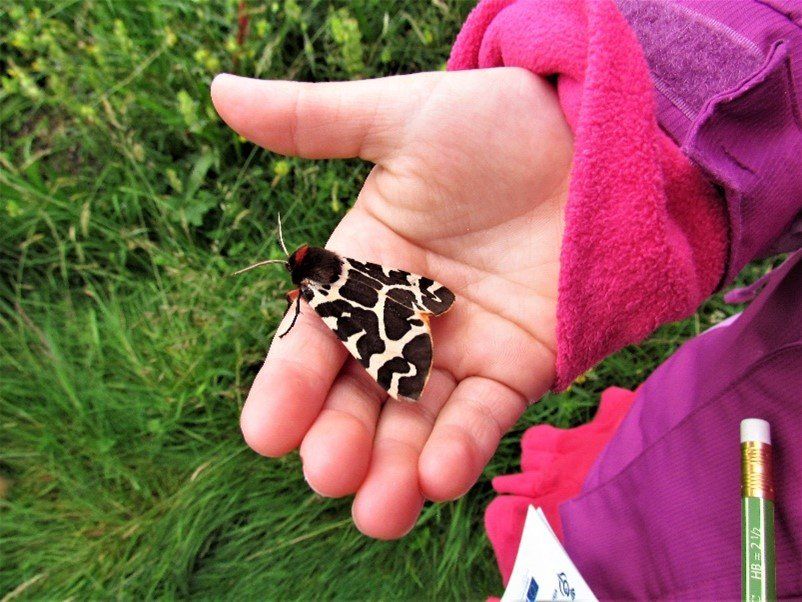

Why Moths?
Moths are pollinators too! We all know and love the Bumble Bee, but often overlook other flying invertebrates’ vital contribution to pollination and plant growth. Moths are much more diverse than butterflies, and include some species that are even more striking. About 34 species of butterfly are seen regularly in Scotland, but about 1,300 species of moth occur here. A widespread myth is that all moths eat clothing. In fact, of the 2,500 moth species that live in the UK, very few species will eat fabrics such as wool. Moths have been around for at least 50 million years and make up about 25% of all species of insects on the planet! Moths are an important link in the food chains that join all the Earth’s plants, animals and fungi. For example, in the UK, Blue Tits alone eat about 50 million moth caterpillars every year! Moths are some of natures most talented camouflage artists, often resembling so closely with their food plants that, unless they moved, you’d never know they were there. Moths and their caterpillars have many predators and so have evolved a variety of tricks to avoid being eaten. Many use camouflage, with subtle colours and patterns which blend in with their surroundings. The results are not just astonishingly clever, but often very beautiful.
Meet the Moth’s recorded at Kinghorn Loch!
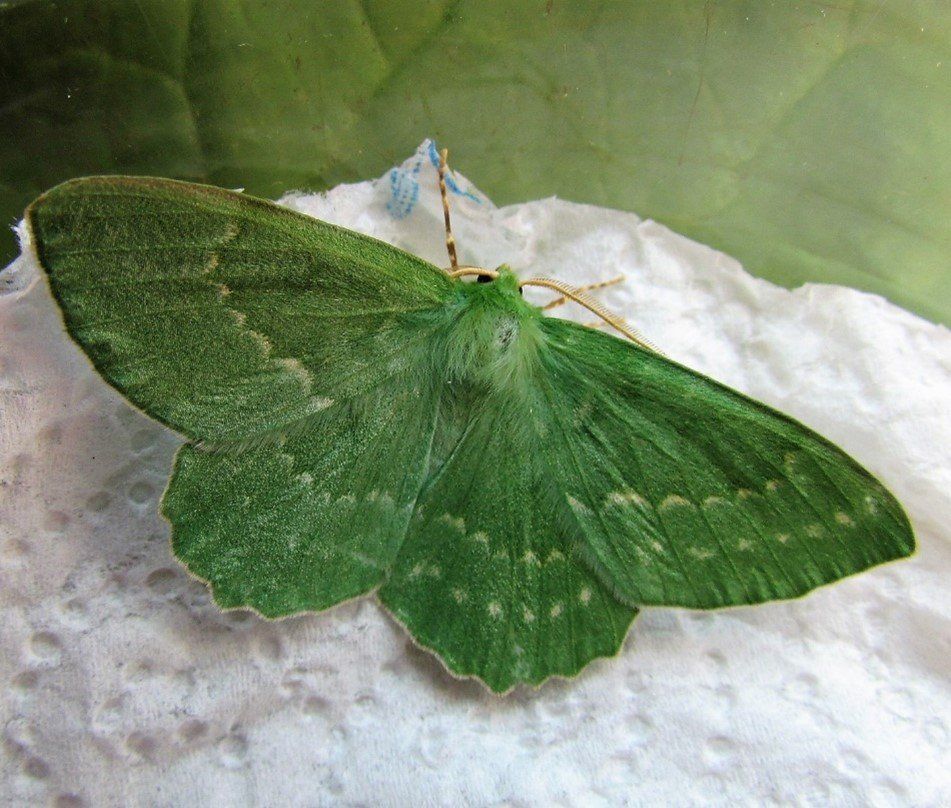
The Large Emerald Moth (Geometra papilionaria)
Easily identified by its large size and the scalloped edge to the wings. White cross-lines are also scalloped with lines of white dots below.
The adults rest with wings spread and raised at an angle similar to a butterfly. They fly at night and are attracted to light but also occasionally fly high in the tree canopy on warm, sunny days.

Light Emerald Moth (Hemistola chrysoprasaria)
The wings are rounded with two white cross-lines on the forewings and a single cross-line on the hindwing. They are a rich blue-green colour fading to white with age.
The adults fly at night from dusk and are attracted to light. The caterpillars can be found from July or August to the following June overwintering as larvae. They pupate in a cocoon suspended by threads from the foodplant.
Caterpillar Food Plants- Traveller’s-joy (Clematis vitalba)
Occasional records in southern Scotland and the north-east of Ireland, More commonly found in England and Wales.

Gold Spot (Plusia festucae)
Damp places, such as fens, water-meadows and river banks are the favourite haunts of this colourful species.

Garden Tiger Moth (Arctia caja)
The garden tiger is an attractive, brown-and-white moth of sand dunes, woodland edges, meadows and hedgerows; it will also visit gardens. Once a fairly common sight the Beautiful Garden Tiger Moth is in decline, suffering from the 'tidying up' of our countryside.
The striking caterpillars are large, black and covered in long, dense, black and ginger hairs and they are commonly called 'Woolly Bears'. They feed on stinging nettles, dock leaves and many garden plants.

Swallow tailed Moth (Ourapteryx sambucaria)
The adults are occasionally disturbed during the day but they are strictly nocturnal flying rapidly at night. They are attracted to light. They overwinter as caterpillars in a bark crevice.
Woody broadleaves including Blackthorn (Prunus spinosa), Hawthorn (Crataegus monogyna) and Goat Willow (Salix caprea) as well as Elder (Sambucus nigra), Horse Chestnut (Aesculus hippocastanum) and Ivy (Hedera helix).

Peach Blossom Moth (Thyatira batis)
Remember that moths are great at disguise? George has a theory that the Peach Blosson, although very pretty could be imitating a bird poo to hide from preditors!
The adults fly at night and are attracted to light. In the day, they hide in ground cover.

Broad bordered Yellow Underwing (Noctua fimbriate)
Large Yellow Underwing (Noctua pronuba)
Broad Bordered (pic left) occurs in any suitable habitat, but seems to prefer woodland, throughout most of Britain, though it is less common in Scotland.
These two may look dull at first but when startled they will show their bright yellow/orange underwing. Hidden in this resting pose.
Possibly the most abundant of our larger moths, this species can be found throughout Britain, and numbers are often enhanced by large migratory influxes in the south.
Large Yellow Underwing (Noctua pronuba) (Pic right) exhibits a wide range of colour forms and patterns, although the yellow hindwings bordered with black remain.

Burnished Brass (Diachrysia chrysitis)
One of my Favourites found at Kinghorn Loch. Part of the Noctuidae family, a Group of moths which have striking body shapes and in my opinion the coolest looking hairstyles.
This unmistakeable moth has a spectacular brassy, metallic sheen on the forewings. The adults feed at dusk at the flowers of Honeysuckle, buddleias and Red Valerian.
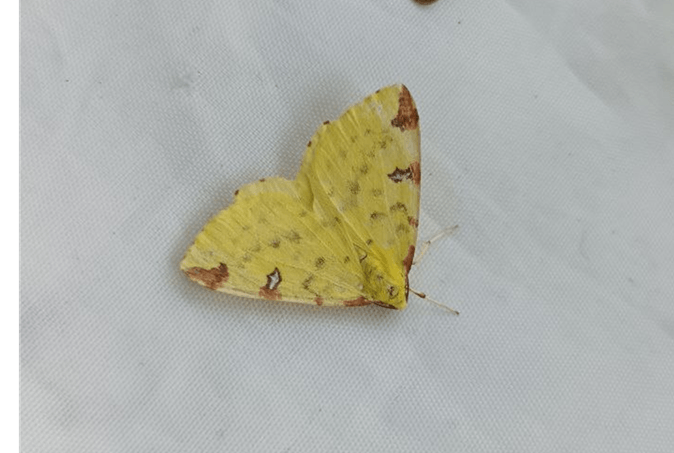
Brimstone Moth (Opisthograptis luteolata)
An unmistakable yellow moth with chestnut-brown markings on the tips and along the leading edge of the forewings. They also have a white crescent or dash near to the leading forewing edge.
A range of trees and bushes including Blackthorn (Prunus spinosa), Hawthorn (Crataegus monogyna), and Rowan (Sorbus aucuparia).Brimstone Moth (Opisthograptis luteolata)
An unmistakable yellow moth with chestnut-brown markings on the tips and along the leading edge of the forewings. They also have a white crescent or dash near to the leading forewing edge.
A range of trees and bushes including Blackthorn (Prunus spinosa), Hawthorn (Crataegus monogyna), and Rowan (Sorbus aucuparia).

Magpie Moth (Abraxas grossulariata)
Currant and gooseberry bushes (Ribes spp.), Blackthorn (Prunus spinosa), Hawthorn (Crataegus monogyna), Hazel (Corylus avellana), Garden Privet (Ligustrun ovalifolium), Spindle (Euonymus europaeus) and Bramble (Rubus fruiticosus) as well as heathers in northern Scotland.

Peppered moth (Biston betularia)
The caterpillars of the peppered moth not only mimic the form but also the colour of a twig. Recent research indicates that the caterpillars can sense the twig's colour with their skin and match their body colour to the background to protect themselves from predators.
To human eyes the Moths are very well camouflaged against lichens and plain bark. Birds can see in Ultra Violet light, and the Moths are therefore only disguised in Lichens with which they share an ultraviolet pattern.
Hawk Moths
You may be familiar with the infamous death heads hawk moth (Acherontia Atropos) named due to the markings on the upper body said to look like a human skull.
There’s 18 species of Hawk Moths in the British Isles and Ireland, They are big and beautiful Moths. With large chunky bodies and diverse characteristics. Some Hawk moth’s species can be mistaken for a large bee or even a humming bird!
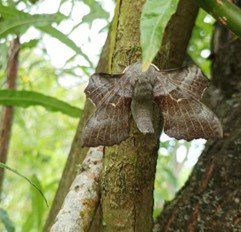
Poplar hawk-moth (Laothoe populi)
The greyish-brown poplar hawk-moth rests with its hindwings visible beyond the leading edge of the forewings and its abdomen curled upwards, giving it an unusual profile. When alarmed it flashes brick red patches on the hindwings which are usually hidden. Some individuals can be tinged pink or purple.
Wingspan can be up to 9cm across.
Caterpillar foodplants
Poplars, aspen, willows and sallows.

Lime hawk-moth (Mimas tiliae)
This moth can be variable in colour, with combinations of greens, pale browns and pinks. It usually has darker patches in the centre of the forewings which are not always broken. Look also for the ragged trailing edges of the forewings and the upturned abdomen.
Food plants: Limes (as the name suggests) but also a range of other deciduous trees including birch, elm, alder and London plane.
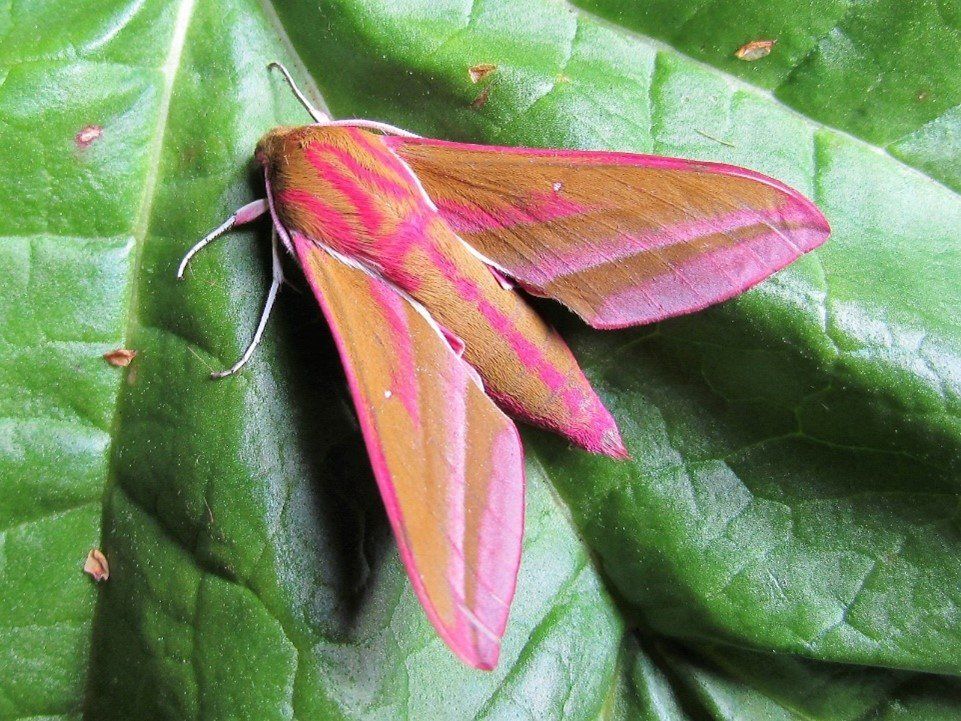
Elephant Hawk Moth (Deilephila elpenor)
Caterpillar Food Plants:
Rosebay Willowherb (Epilobium angustifolium), other willowherbs, bedstraws (Galium), Enchanter’s Nightshade, fuchsias and Himalyan Balsalm.
Distribution: Thinly distributed in Scotland, very local and rare in the Channel Islands.
Day Flying Moths
That’s right, a common misconception is that all moths fly at night, actually there’s a number of day flying moths blurring the line between what we consider the differences between moths and butterflies might be. You might have seen bright yellow and black striped caterpillars on ragwort? Those are Cinnabar moth (Tyria jacobaeae) caterpillars. Cinnabar moths can be seen flying during the day and night and are often mistaken for butterflies.
Though often considered a weed Ragwort (Senecio jacobaea) is the main food plant for this species and therefore plays a vital role in the ecosystem. The caterpillars bright colour tells predators they are poisonous, the toxins are built up as the caterpillar eats the ragwort- so the ragwort is their food and mainline difference!
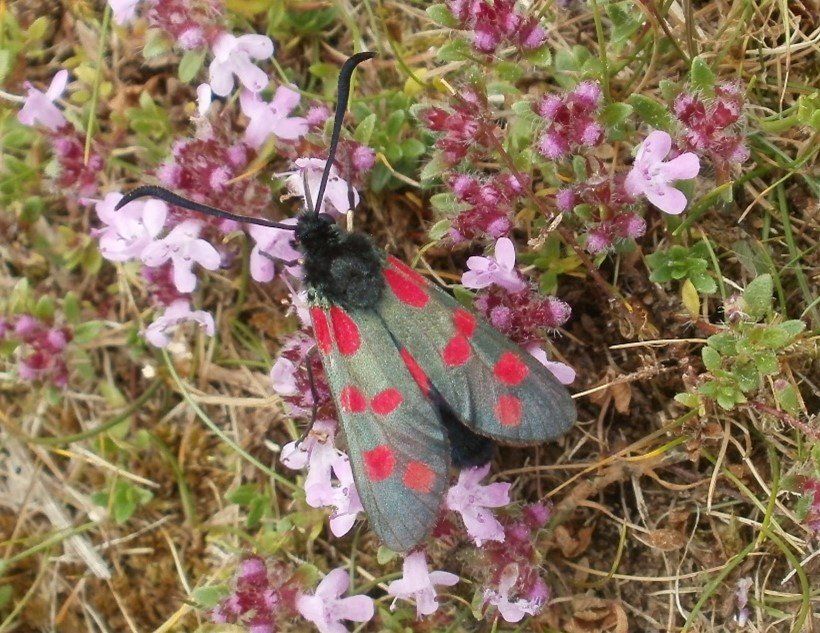
Six Spot Burnet Moth (Zygaena filipendulae)
A medium-sized, day-flying moth, commonly found in grasslands, woodland rides and sand dunes, where the caterpillars feed on common bird's-foot trefoil. The adults feed on the nectar of knapweed, thistles and other grassland flowers, and females lay their eggs on the caterpillars' foodplants. The caterpillars hatch and feed, hibernating over at least one winter. They emerge the following spring and pupate in a papery cocoon attached to grass stems.

Chimney Sweep Moth (Odezia atrata)
This distinctive moth has sometimes been mistaken for the Small Blue butterfly. It rarely varies in colour but may become browner with wear. This moth is usually very active by day, especially in sunshine.
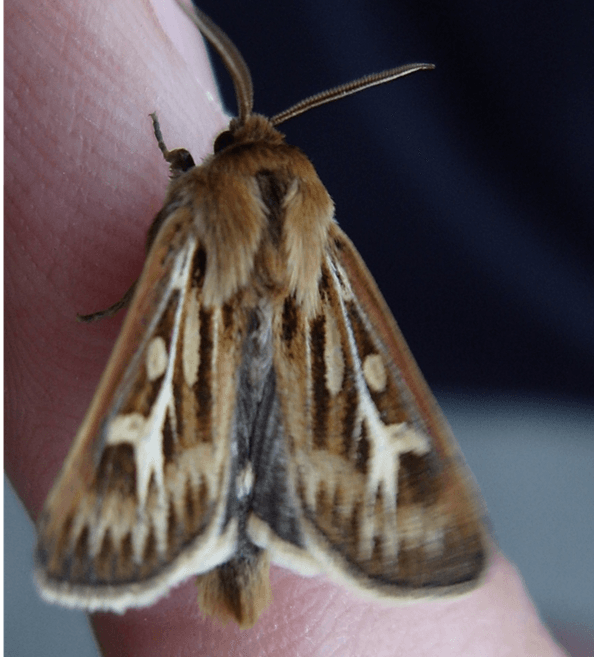
Antler Moth (Cerapteryx graminis)
This distinctive moth is distinguished by its cream, antler-shaped mark which varies in size on the forewing. Black streaks on the forewing may or may not be present. Males are smaller than females and have feathered antennae.
The adults fly during the day, especially in the north and more frequently in the morning. They can be found feeding at flowers such as thistles and ragworts and can also fly at night.

Common Plume (Emmelina monodactyla)
Rests with wings tightly rolled, resembling a small cross. Usually a greyish-white to brown in colour. Each pair of spurs on the hind legs has one spur longer than the other.
The adult moth is often seen on fence posts, walls and even indoors where they are attracted to light. Can also be found at Ivy blossom, ripe blackberries and, in spring, at sallow blossom.
The caterpillars feed on Bindweeds.
References
www.butterfly-conservation.org
https://www.wildlifetrusts.org
Photo’s curtesy of George Guthrie and Myrtle Mirewood
Collated by Myrtle Mirewood